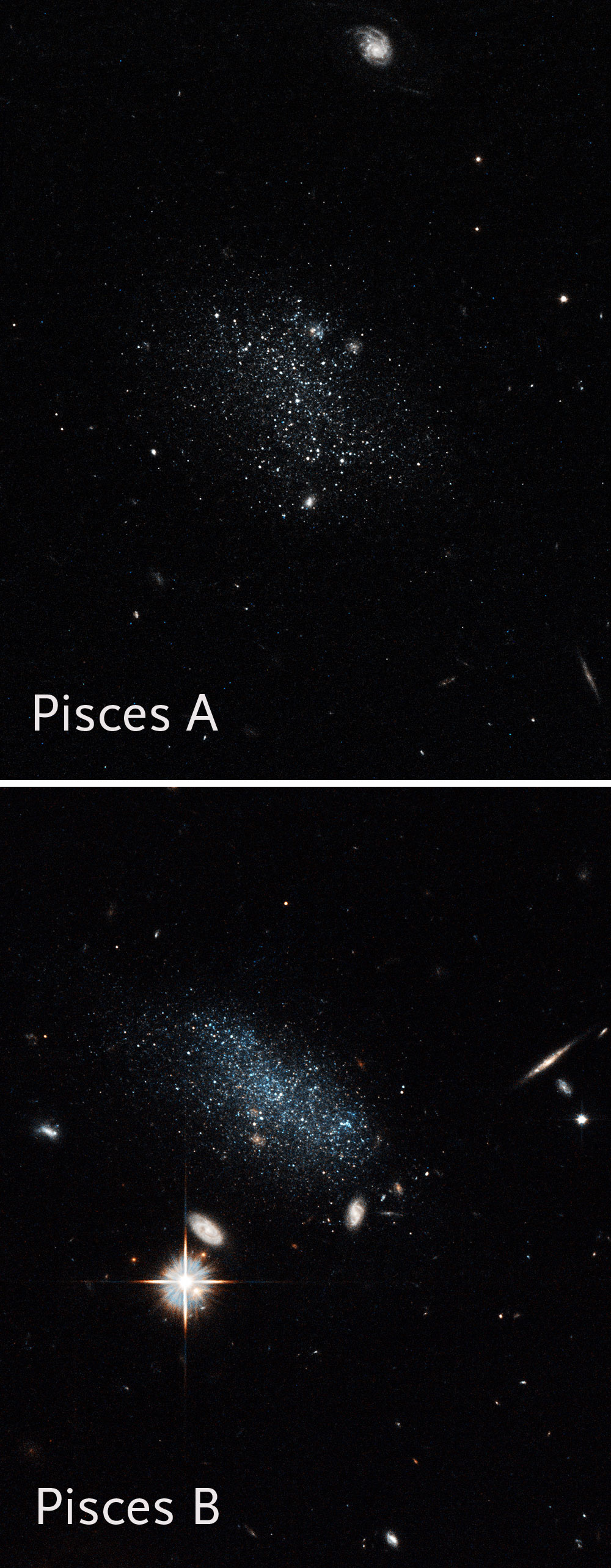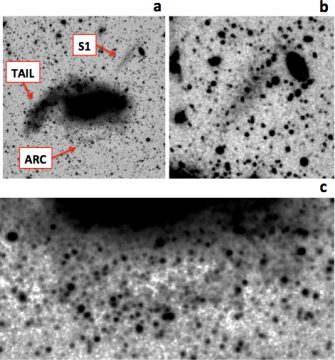.
Living in voids might be tangentially responsible for three small galaxies’ recent flurries of starbirth.
Dwarf galaxies are galactic runts. They can be a thousandth (give or take a factor of 10) as massive as our galaxy, the Milky Way. Because they’re so small, they’re sometimes their own worst enemies: if a few supernovae go off inside, the blasts can expel all the dwarf’s gas, stifling star formation until the gas can cool and rain back down — if it ever does.

These Hubble images show two distant, dwarf galaxies that lie in a part of the cosmic web bordering the Local Void. Although most of their stars are old, they do contain a couple dozen young, blue stars that were born in the last couple hundred million years.
NASA / ESA / E. Tollerud (STScI)
Two different teams have now found dwarf galaxies with ramped-up star formation, giving us a look at what triggers starbirth in these little systems. But what makes these particular dwarfs neat is that they might be in their current state thanks to voids, the gaps in the cosmic web of galaxies that make the large-scale universe look like a sponge.
Coming in from the Void?
Erik Tollerud (Space Telescope Science Institute) and colleagues used Hubble to spot two tiny dwarfs, called Pisces A and B. They lie about 20 and 30 million light-years away, respectively, beyond the Local Group of stellar metropolises that cluster around the Milky Way and Andromeda galaxies.
Pisces A and B are puny, each only a couple thousand light-years across. They don’t have many stars, either — each holds on the order of 10 million suns. For comparison, the Milky Way contains approximately 100 billion stars, and its disk spans more than 100,000 light-years. So these dwarfs are basically faint, sparse clouds of stars held together by dark matter.
The team’s observations reveal that Pisces A and B lie on the edge of a nearby cosmic desert called the Local Void. Each dwarf also boasts a couple dozen young, blue stars. In fact it looks like the galaxies both experienced upticks in their star production within the last 300 million years.
One explanation for the bevies of beautiful stars is that their births were triggered by the dwarfs’ migration through space: perhaps they recently left the Local Void and entered the strand of the cosmic web they’re now in. More gas floats around in the web’s filaments and sheets than in the voids, and as a galaxy entered a strand, the pressure of ramming into this ambient stuff could compress the gas inside the galaxies, triggering star formation. Indeed, several astronomers have suggested that this process could kick start starbirth or even kill it by tearing the gas out of a galaxy.
But as the team explains in the Astrophysical Journal, it hasn’t measured the dwarfs’ motions — the researchers only know the locations of Pisces A and B, not where they’re coming from or where they’re going. The idea that their star formation is being spurred on by entering the web is only an extrapolation based on where the dwarfs currently lie.
Tollerud acknowledges that the star formation might be internally triggered, by the cooling and raining-down process I described earlier. But dwarfs are notoriously on-again-off-again in their star formation, and the astronomers originally found these galaxies by looking for clumps of gas, not stars — so they didn’t discover Pisces A and B because of the burst of starbirth. “It would seem like quite the luck that the only two we found happen to be the ones that are in their uptick right now,” he says.

These sections of the Large Binocular Telescope observations of the dwarf galaxy DDO 68 reveal a heretofore unrecognized arc and stream (labeled S1 in image "a"). Image b is a zoom-in on the stream; image c is a zoom-in on the arc. The image has been smoothed to make structures more obvious.
Francesca Annibali / INAF
Fleas on Fleas
A different dwarf galaxy with the stirring name DDO 68 definitely lies in a void — the Lynx-Cancer void, roughly a third of the way around the sky from Pisces A and B. DDO 68 lies about 40 million light-years away. Its gas is incredibly pristine, barely tainted by the heavier elements created in stars. It’s also distorted, with a curving tail that kind of makes it look like a fried jumbo shrimp.
Thanks to its oddball shape and tail, which contains stars of all ages, astronomers already suspected that DDO 68 has been tidally pulled on, or even merged with, one or more dwarfs. Francesca Annibali (INAF-Bologna Observatory, Italy) and colleagues decided to look more carefully using both Hubble and the Large Binocular Telescope, the latter of which has a much wider field of view than Hubble and can thus more easily reveal substructures.
As reported in the August 1st Astrophysical Journal Letters, the team found an arc and at least one notable stream of stars near the galaxy’s edges. Stars in the arc have all sorts of ages, but some are as young as 50 million years old — astronomically speaking, they were born yesterday. The stream’s stars are older, at least 2 billion years old.
Based on computer simulations, the team thinks that DDO 68’s harried look could be the result of eating two, even smaller dwarfs. Although voids are supposedly empty, the term “void” can be misleading, Annibali explains. By definition they’re bereft of big, bright galaxies, but little galaxies sometimes live in them.
Plus, she adds, astronomers expect galaxies to live in associations, with dwarfs hosting their own satellites. Such a miniature clique wouldn’t survive long near a massive galaxy like the Milky Way — and there are hints that some of the satellites our galaxy is munching on began life together in groups — but it could survive for much longer in a void, she says.
But it’s unclear whether these structures really are from smaller galaxies that DDO 68 is eating, Tollerud cautions. Dwarfs often have weird shapes, even in the absence of interactions, or maybe the galaxy ate a star cluster. We need higher-resolution images to reveal what these truly features are, he says.
Quelle: Sky&Telescope
